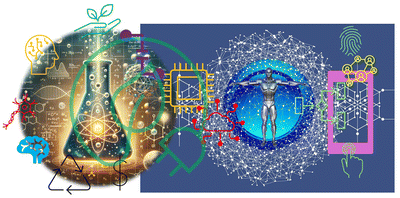 Open Access Article
Open Access ArticleCreative Commons Attribution 3.0 Unported Licence
Introduction to Advanced materials for sensing and biomedical applications†
Yogendra Kumar
Mishra
 a,
Ajeet
Kaushik
a,
Ajeet
Kaushik
 b and
Avtar
Singh
b and
Avtar
Singh
 c
c
aSmart Materials, Mads Clausen Institute, University of Southern Denmark, Denmark. E-mail: mishra@mci.sdu.dk
bFlorida Polytechnic University, USA. E-mail: akaushik@floridapoly.edu
cMolekule Group Inc., USA. E-mail: avtarldh007@gmail.com
 Yogendra Kumar Mishra |
 Ajeet Kaushik |
There is no doubt that better control over the properties of nanomaterials would enable their involvement in many important applications, including sensing and biomedical technologies, with outstanding performances. However, there is plenty of scope to develop (1) next-generation sensing technologies capable of performing in point-of-care applications and (2) biomedical technologies of higher efficacy, tuneable in a personalized manner, with affordability and minimal adverse effects. In this direction, efforts are being made to develop multifunctional materials that are stable, economically and ecologically acceptable, and deliver desired properties in a controlled manner. These tasks seem achievable with the support of green chemistry and the involvement of artificial intelligence (AI) to optimize a material with improved benefits and a manageable related risk assessment. Once optimized and developed at a large scale, these functional materials will be very useful in supporting sustainability through interfacing with the Internet-of-Things (IoT).
This themed collection on “Advanced materials for sensing and biomedical applications” is focused on the developments of next-generation sensing technologies capable of point-of-care applications and biomedical engineering, with high efficacy and tuneable properties for targeted delivery with simultaneous minimal adverse effects. This collection has attracted experts’ attention and become a popular themed collection for the journal. We are delighted to see the variation among the submitted articles, which are of great significance. We hope that this themed collection will serve as a key resource that will guide scholars to explore all the dimensions of materials science, with a focus on the design and development of advanced sensing and biomedical technologies, as illustrated in Fig. 1.
The urgent imperative to combat cancer has sparked extensive global research efforts spanning tumor biology, treatment innovation, diagnostics, prevention, and accessible care. Driven by the profound impact of cancer on individuals and society, these efforts emphasize collaborative and interdisciplinary approaches to tackle its complexity, ultimately aiming to alleviate suffering and advance medical science toward conquering this formidable adversary.
This themed issue delves into the latest advancements in the exploration of advanced materials for cancer research. Verma et al. addressed the urgent need for early detection of esophageal cancer (EC) with a paper-based biosensor detecting EC biomarkers CYFRA21-1 and TP53 in serum, providing a non-invasive and cost-effective diagnostic alternative (https://doi.org/10.1039/d3ma00438d). Another group of authors configured a review work highlighting the limitations of current cancer detection methods, emphasizing the potential of electrochemical sensors and nanomaterials for simpler, faster, and non-invasive detection, aiming to underscore the critical importance of early diagnosis in improving survival rates and treatment outcomes (https://doi.org/10.1039/d3ma00621b). Similarly, Khondakar et al. contributed a perspective on the importance of early cancer detection, with a focus on point-of-care technologies and electrochemical sensors enhanced with nanomaterials (https://doi.org/10.1039/d3ma00525a). Building on these diagnostic advancements, Pandya et al. explored the targeting of mitochondria for enhanced cancer treatment by utilizing engineered nanomaterials loaded with chemotherapy drugs (https://doi.org/10.1039/d3ma00629h). Advances in imaging technologies also play a crucial role in cancer research. Mutreja et al. presented a study on high-atomic-number nanoparticles as contrast agents that hold promise for improving spectral CT imaging, which can enhance cancer diagnosis and treatment planning (https://doi.org/10.1039/d3ma00231d). Exploring the physicochemical properties of these nanoparticles and future research directions underscores their potential to enhance clinical outcomes through improved imaging capabilities. By synthesizing stable L-graphene and D-graphene through liquid-phase exfoliation with L-tyrosine and D-tyrosine, Pranav et al. explored the potential of these chiral graphene materials for gene delivery in prostate cancer treatment. This pioneering effort underscores the role of nanomaterials in advancing precision medicine and targeted therapies (https://doi.org/10.1039/d3ma00611e).
Beyond cancer, various studies showcase the diverse applications of nanotechnology across several fields of technology. For instance, tailored graphene-based nanomaterials have been explored for Parkinson's disease (PD) diagnosis and treatment (https://doi.org/10.1039/d3ma00623a). Computational and experimental approaches elucidate the potential of graphene in targeting mechanisms contributing to PD neurodegeneration, offering insights into future nanomedicine and biosensor applications for neurodegenerative disorders. Furthermore, the fusion of machine learning with neuromorphic materials presents transformative opportunities across artificial intelligence, robotics, and cognitive science (https://doi.org/10.1039/d3ma00449j). By optimizing material architectures for self-adaptive systems and enhancing brain–machine interfaces, this interdisciplinary research aims to revolutionize AI and computational efficacy. These interdisciplinary efforts highlight nanotechnology's transformative potential in addressing various complex challenges. Amidst the COVID-19 pandemic, Sadique et al. demonstrated a novel immunosensing strategy using a C3N4/RGO/Chi nanocomposite with remarkable sensitivity in detecting SARS-CoV-2 antibodies, promising efficient point-of-care testing for infectious diseases and paving the way for future diagnostic advancements (https://doi.org/10.1039/d3ma00399j). Meanwhile, the synthesis and applications of low-molecular-weight carbohydrate-based gelators have emerged as promising avenues in biomedical fields (https://doi.org/10.1039/d3ma00321c). With their biocompatibility and renewable nature, such gelators offer versatile solutions for drug delivery, tissue engineering, and environmental remediation, contributing to sustainable development efforts. In the realm of diabetes mellitus therapy, nano-based therapeutics offer a paradigm shift in treatment strategies (https://doi.org/10.1039/d3ma00159h). By enhancing drug bioavailability and specificity, nano-formulations pave the way for improved diabetes management, encompassing nano-based drug therapy, advanced sensors for monitoring, and targeted approaches for managing complications like wound healing.
Researchers have prioritized sustainability in biosensing-device design, favoring eco-friendly materials like paper and cellulose. Kumar et al. present the fundamentals of biosensing concepts and sustainable materials. They explore how these materials are utilized in developing paper-based biosensing devices for various applications in healthcare, agriculture, the food industry, environmental monitoring, and other fields (https://doi.org/10.1039/d3ma01019h). Cellulose nanocrystals (CNCs) show promise in sensing applications due to their eco-friendly nature and unique properties (https://doi.org/10.1039/d3ma00601h). Singh et al. presented a review discussing recent progress in CNC-based sensor development for detecting environmental hazards, metals, and gases, along with methods for enhancing CNC-based substrates and smart sensor design. Pandit et al. highlight the significance of monitoring stress for personalized health management through saliva analysis. The authors focus on various salivary biomarkers like cortisol and advanced sensing technologies such as biosensors, which offer non-invasive, accurate methods for detecting stress and enabling personalized interventions. (https://doi.org/10.1039/d3ma00937h). Khondakar et al. reviewed 2D nanostructures like graphene and MXenes as telemedicine platforms, highlighting their potential in biosensing, drug delivery, bioimaging, and AI integration for advanced healthcare solutions (https://doi.org/10.1039/D4MA00234B). Gupta et al. formulated a review highlighting the exceptional properties of borophene and its potential applications in biosensors and green energy technologies (https://doi.org/10.1039/d3ma00829k). Güell et al. discuss research into enhancing the performance of zinc oxide for practical applications, such as optoelectronics and sensing (https://doi.org/10.1039/d3ma00227f). Paramasivam et al. introduce a smart sensor for detecting salivary nitrite, utilizing copper chlorophyllin (CuCP) on multi-walled carbon nanotube (MWCNT) electrodes, offering high sensitivity validated for real-world applications (https://doi.org/10.1039/d3ma00634d). Yadav et al. reviewed advancements in amyloid fibrils' structural characterization, synthesis, and applications in healthcare, sensing, and the environment, highlighting their mechanical strength, self-assembly, stability, biocompatibility, and potential as sustainable alternatives to synthetic materials (https://doi.org/10.1039/D3MA00969F).
Humidity sensors are crucial across various fields for maintaining optimal environmental conditions and ensuring safety. In healthcare, they prevent bacterial growth and are used in devices like ventilators and incubators. In agriculture, they optimize moisture levels for better crop yield. In the food industry, they ensure proper storage conditions to prevent spoilage. Additionally, in environmental monitoring, they provide essential data for managing air quality and climate control.1 In this collection, the authors of two pioneering studies delved into innovative approaches for humidity sensing using distinct materials. In one study, the authors have explored the integration of tungsten ions into 2D hexagonal mesoporous COK-12, leading to enhanced sensitivity and response speed under humid conditions (https://doi.org/10.1039/d3ma00691c). Their findings shed light on the potential of COK-12-based sensors for various applications, from environmental monitoring to industrial processes. The second study focused on synthesizing 3D nanocomposites combining ZnO nanoparticles with aTUD-1 host matrix (https://doi.org/10.1039/d4ma00191e). These nanocomposites exhibited superior humidity-sensing capabilities and remarkable photocatalytic activity, suggesting their utility in both sensing and environmental-remediation applications. Sura et al. explored the synergistic effects of sulfur-doped g-C3N4 (SCN) and carbon dots (CD) in nanocomposite photocatalysts, finding that SCN/CD3 effectively degrades contaminants like bisphenol A and tetracycline, showing high efficiency and reusability in photocatalytic degradation of emerging pollutants (https://doi.org/10.1039/D4MA00270A). By bridging these studies, it becomes evident that innovative material synthesis approaches hold promise for addressing multifaceted challenges in fields ranging from sensor technology to wastewater treatment, thereby contributing to advancements in both environmental monitoring and sustainable industrial processes.
Gas sensor technology is an advancing field that is becoming more useful when interfaced with AI for analyzing data to make decisions. Such sensors convert complex response-based data into practical insights to explore challenges and optimize solutions. Their applications span across medicine, environmental monitoring, industry, automotive safety, and agriculture. Two studies delve into innovative approaches in gas-sensing technology, albeit with different materials and focus. One study introduces a novel low-temperature NO2 gas sensor, employing a heterojunction of reduced graphene oxide (rGO) and BiOCl (https://doi.org/10.1039/d4ma00168k). This sensor exhibits impressive sensitivity, selectivity, and rapid response times, offering accurate detection even at low temperatures. Another paper presents a review exploring the potential of a Ti3C2Tx MXene in gas-sensing applications, detailing its properties, mechanisms, and recent advancements (https://doi.org/10.1039/d3ma00631j). Despite their material disparities, both studies contribute to advancing gas-sensing technology, showcasing diverse strategies for improving sensor performance and addressing key challenges. While one focuses on the specific application of NO2 detection with a new sensor design, the other provides a broader overview of MXene-based sensors, highlighting their versatility and potential in gas sensing across various contexts. Together, they underscore the significance of continuous research and innovation in developing efficient and reliable gas-sensing devices for various practical applications, from environmental monitoring to industrial safety.
This themed issue received contributions that support both environmental and food-safety technologies. Borah et al. used a non-toxic hydrothermal method to synthesize spherical SnO2 nanoparticles, which effectively removed 95.96% of Congo red dye from water within one minute (https://doi.org/10.1039/d3ma00615h). The adsorption process, driven by electrostatic attraction and hydrogen bonding, was enhanced by oxygen vacancies. Encapsulation in sodium alginate prevented metal leaching and maintained 75% efficiency, demonstrating the nanoparticles' potential as sustainable, efficient nano-adsorbents for wastewater treatment. On the other hand, Sonwal et al. developed a portable, one-step colorimetric sensor for detecting calcium carbide (CaC2) in artificially ripened fruits (https://doi.org/10.1039/d3ma00212h). Utilizing 5,5′-dithiobis-(2-nitrobenzoic acid) (DTNB), the sensor produces a yellow color in the presence of CaC2, indicating free sulfhydryl groups. This sensor, with a detection limit of 50 ppm and a linear range of 0–4000 ppm, provides results from within seconds to a minute. This system exhibited a high sensitivity, selectivity, and cost-effectiveness. These features make it a valuable consumer-level screening tool for agriculture, food safety, and cosmetics. Simultaneously, efforts to combat antibiotic resistance drive the development of portable, sensitive point-of-care devices for detecting antibiotic residues in food samples. A comprehensive review emphasizes the urgent need for such devices and explores emerging optical and electrochemical methods (https://doi.org/10.1039/d3ma00632h). Integrating sensing technologies and artificial intelligence promises enhanced surveillance capabilities, crucial for mitigating the global threat of antibiotic resistance.
Researchers are continuously exploring new materials for electromagnetic interference (EMI) shielding based on polymer nanocomposites. Yadav et al. introduced a one-pot thermal method to synthesize a polyaniline/tellurium (PANI/Te) nanocomposite using 2-mercaptoethanol (MPE) as a reducing agent (https://doi.org/10.1039/d3ma00394a). Thorough characterization techniques confirmed the composition and structure of PANI/Te, which showed promising EMI shielding capabilities. The addition of 4 wt% silver nanoparticles (Ag NPs) further enhanced the shielding capabilities when integrated into polyvinyl alcohol (PVA) matrices. Another investigation by Moolemane et al. examined the influence of nanoclay on the properties of silver-decorated polyaniline nanocomposites. By incorporating varying amounts of nanoclay using in situ polymerization, the researchers observed improvements in electrical conductivity and significant attenuation in EMI shielding. The study also revealed a linear relationship between nanoclay weight and humidity sensitivity, suggesting potential applications in sensor technology and EMI shielding materials. These findings contribute to the development of versatile materials for technological advancements in EMI shielding (https://doi.org/10.1039/d3ma00393k). In another effort, Bansal et al. synthesized microcrystalline MoO3 using a sol–gel method to explore its use in energy storage devices and HF sensing (https://doi.org/10.1039/d3ma00357d). They demonstrated its high specific capacitance, stability, and sensitivity, making it suitable for real-life applications.
Antimicrobial coatings are crucial for controlling pathogen spread by inhibiting their interaction with surfaces. They contain substances like silver nanoparticles or antimicrobial polymers to disrupt microorganisms' cellular processes. Widely used in healthcare and consumer products, these coatings reduce the risk of infections and promote hygienic environments while also contributing to environmental sustainability. Prabhu B et al. introduce MMO–Ag, a nano-formulation effective against bacteria and viruses, capable of rendering fabric self-cleaning under UV light (https://doi.org/10.1039/d3ma00951c). Nirmala et al. developed a resilient antibacterial coating for cotton face masks, utilizing multi-charged metal complexes anchored on TiO2 and binary nanoparticles with silver and copper, offering durability against diverse bacteria strains through multiple wash cycles (https://doi.org/10.1039/d3ma00605k). Kaushik et al. demonstrated a low-cost, flexible dielectric barrier discharge plasma device using hand-drawn pencil on paper as electrodes, capable of producing atmospheric pressure plasma, operating continuously for over 30 minutes, and effectively inhibiting pathogenic bacteria within 120 seconds (https://doi.org/10.1039/D3MA01122D). Smith et al. developed highly conductive and biocompatible PEDOT fibres with an optimized polyaniline coating, creating effective wearable pH sensors. These fibres exhibited a Nernstian response across a wide pH range (3.0 to 9.0) and demonstrated antibacterial properties. This innovation holds significant promise for future wearable textile-based sensors, enabling real-time, on-body monitoring of skin and wound healing (https://doi.org/10.1039/D3MA00711A). Together, they highlight the potential of advanced nanotechnology in enhancing antimicrobial properties for textiles and personal protective equipment, promoting both public health and environmental sustainability.
Altogether, these interdisciplinary research efforts underscore the transformative potential of nanotechnology in addressing complex challenges across healthcare, environmental sustainability, and advanced diagnostics, highlighting the interconnectedness of innovation in diverse scientific domains. Finally, we are very grateful to Hannah Kerr for putting this together and the editorial staff of the Materials Advances for putting every piece in the right place for the completion of a successful themed collection. At the same time, the incredible service of reviewers in supporting and promoting science is also acknowledged here. We believe that readers and scholars will enjoy reading this themed collection and get the benefit of understanding state-of-the-art materials, exploring the gaps in materials sciences and technology development, and planning future research in the field of next-generation technologies.
References
- A. Singh, J. Dhau, R. Kumar, R. Badru, P. Singh, Y. K. Mishra and A. Kaushik, Prog. Mater. Sci., 144, 101289 CrossRef CAS.
Footnote |
| † Professors Kaushik and Mishra are guest editors, Dr Singh is a contributing author to the editorial. |
| This journal is © The Royal Society of Chemistry 2024 |


